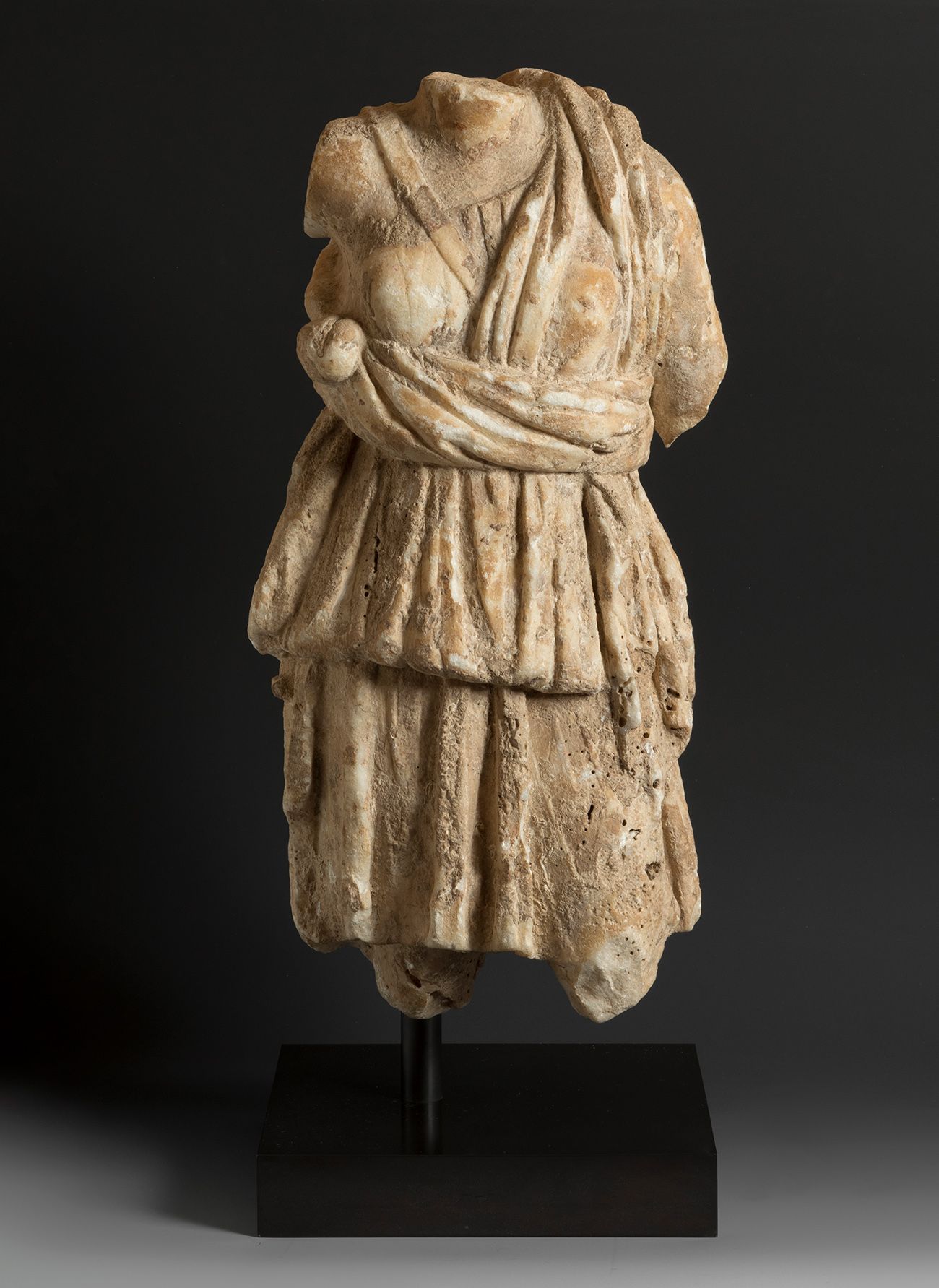Description
Torso of the goddess Diana the Huntress. Roman. 2nd-3rd century AD. Marble. Provenance: private collection, Tel Aviv. Private collection, New York. Purchased at Fortuna Fine Arts, New York, between 1980-2000. Good state of preservation, no restorations. Measurements: 44.5 cm. high; 52 cm. high with pedestal. Roman sculpture in marble. It is the torso of Diana, the goddess of hunting (similar to the Greek Artemis). It is a free-standing piece, worked in the round to be seen from either side, so that the chiton has been masterfully draped with deep naturalistic folds and in different layers, like skilful kolpos at hip level. At the back, a diagonally diagonal garment serves as the strap of the quiver. The goddess of nature, forests and hunting, she must have originally carried a quiver with a bow and arrow, and may have been accompanied by a dog or a piece of game. The influence of Greek statuary is evident. The Romans brought two important innovations to the world of sculpture: portraiture and historical relief, neither of which existed in the Greek world. However, they followed Greek models for much of their sculptural production, a base which in Rome was combined with the Etruscan tradition. After the first contacts with Classical Greece via the Magna Graecia colonies, the Romans conquered Syracuse in 212 BC, a rich and important Greek colony in Sicily, which was adorned with a large number of Hellenistic works. The city was sacked and its art treasures taken to Rome, where the new style of these works soon replaced the Etruscan-Roman tradition that had prevailed until then. Cato himself denounced the looting and decoration of Rome with Hellenistic works, which he considered a dangerous influence on native culture, and deplored the Romans' applause of statues from Corinth and Athens, while ridiculing the decorative terracotta tradition of ancient Roman temples. However, these oppositional reactions were in vain; Greek art had subdued Etruscan-Roman art in general, to the extent that Greek statues were among the most coveted prizes of war, being displayed during the triumphal procession of the conquering generals.
88
Torso of the goddess Diana the Huntress. Roman. 2nd-3rd century AD. Marble. Provenance: private collection, Tel Aviv. Private collection, New York. Purchased at Fortuna Fine Arts, New York, between 1980-2000. Good state of preservation, no restorations. Measurements: 44.5 cm. high; 52 cm. high with pedestal. Roman sculpture in marble. It is the torso of Diana, the goddess of hunting (similar to the Greek Artemis). It is a free-standing piece, worked in the round to be seen from either side, so that the chiton has been masterfully draped with deep naturalistic folds and in different layers, like skilful kolpos at hip level. At the back, a diagonally diagonal garment serves as the strap of the quiver. The goddess of nature, forests and hunting, she must have originally carried a quiver with a bow and arrow, and may have been accompanied by a dog or a piece of game. The influence of Greek statuary is evident. The Romans brought two important innovations to the world of sculpture: portraiture and historical relief, neither of which existed in the Greek world. However, they followed Greek models for much of their sculptural production, a base which in Rome was combined with the Etruscan tradition. After the first contacts with Classical Greece via the Magna Graecia colonies, the Romans conquered Syracuse in 212 BC, a rich and important Greek colony in Sicily, which was adorned with a large number of Hellenistic works. The city was sacked and its art treasures taken to Rome, where the new style of these works soon replaced the Etruscan-Roman tradition that had prevailed until then. Cato himself denounced the looting and decoration of Rome with Hellenistic works, which he considered a dangerous influence on native culture, and deplored the Romans' applause of statues from Corinth and Athens, while ridiculing the decorative terracotta tradition of ancient Roman temples. However, these oppositional reactions were in vain; Greek art had subdued Etruscan-Roman art in general, to the extent that Greek statues were among the most coveted prizes of war, being displayed during the triumphal procession of the conquering generals.
You may also like
